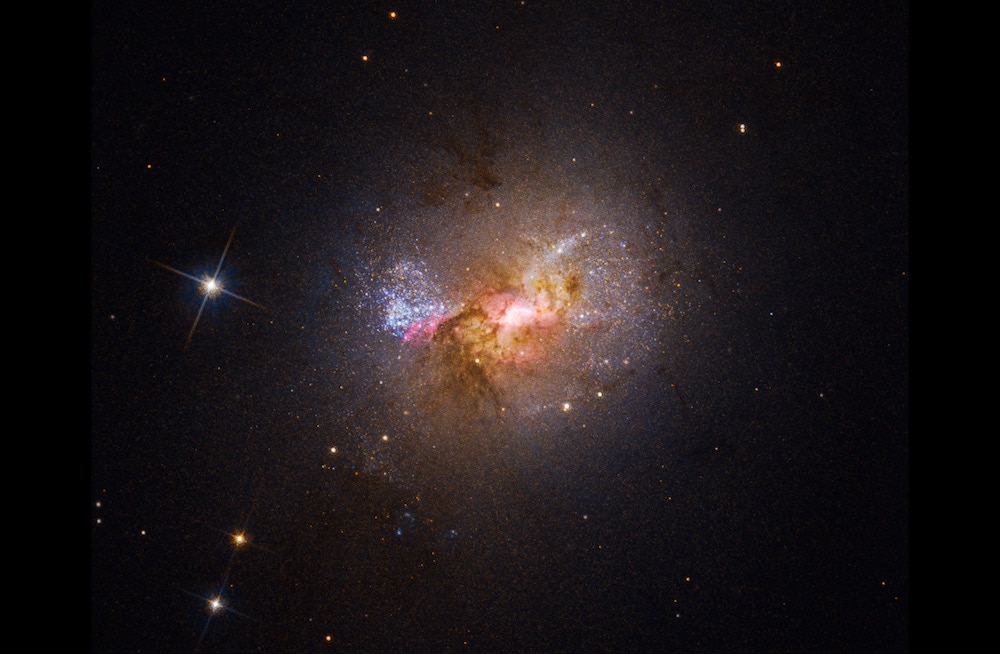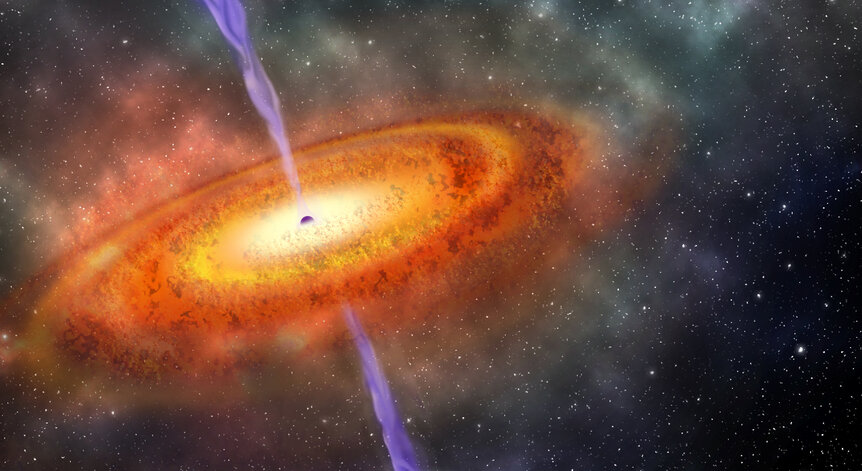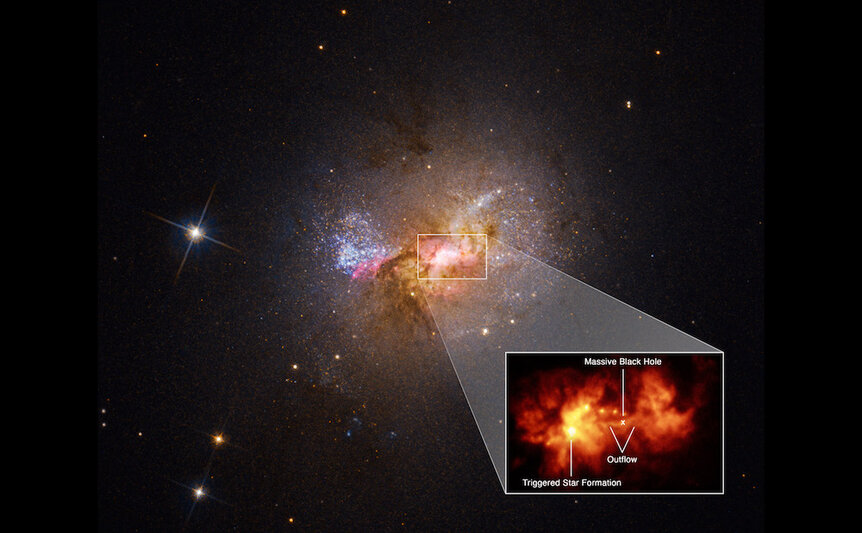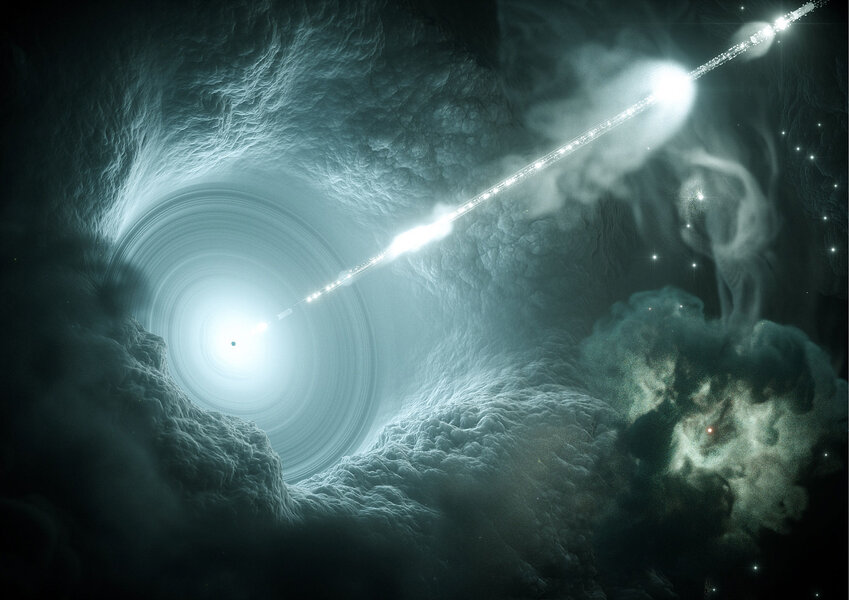Create a free profile to get unlimited access to exclusive videos, sweepstakes, and more!
An enormous black hole is blasting out chaos and… acting as a midwife for stars?
Huge black hole is actually helping stars be born.

When you think of black holes, you probably think of them as agents of cosmic chaos, grabbing everything around them and gobbling it down, a force for destruction on a galactic scale.
That's not entirely untrue, but it is unfair. They can be forces for creation, too.
It's true that they have voracious appetites, and anything that dares venture too close will pass over The Edge of Infinity and be gone forever. But there's more to it than that. Matter falling in with even a slight sideways velocity will have that amplified hugely as approaches the black hole, and, like water circling the drain, will revolve around the black hole some distance out.
This matter forms an accretion disk, a large, flat circular disk that can be light years across for the largest black holes. Friction heats the material up and it gets infernally hot, causing it to glow. For supermassive black holes in the centers of galaxies, this disk can outshine all the light from the stars in the galaxy combined.
It can also create outflows, blowing matter away from the black hole. This can happen in the form of a subatomic particle wind generated just from the heat of the disk, or complex magnetic fields in the disk and the black hole can create twin vortices, like tornadoes, that pull matter up and away from the disk near its center, focusing two beams called jets that blast outward like lighthouse death rays.
But even these don't necessarily spell doom. They're not exactly clement, with matter screaming out at nearly the speed of light, high-energy gamma and X-rays pouring forth, and the like. However, there are two ways this can go. In big galaxies, we see regions of fecund star formation near active black holes, the wind from the colossus compressing surrounding gas clouds, causing them to collapse and form stars. In other places, though, the black hole outflow is so fierce it can literally push that gas out of the galaxy, quenching star formation.
It depends on circumstances. One is the mass of the galaxy. Big galaxies have lots of gravity from all those stars, and the gas is more difficult to blow away. It may get blown out, but eventually slows to a stop and falls back in — we see this in some galaxies, like in NGC 4921.
But some galaxies are smaller. These dwarf galaxies can have supermassive black holes in them, but don't have as much gravity to hold gas in. Does an active black hole in the core of such a dwarf galaxy hinder star formation or help it?
Henize 2-10 is a dwarf galaxy about 30 million light years from us, close enough to see details in it. The core of the galaxy is a mess, clearly disturbed, and blasting out radiation — it's emitting 100,000 times the entire brightness of our Sun in X-rays alone — and that energy is coming from a very compact region just a few light years on a side. It certainly fits the description of a massive black hole.
Unfortunately it also matches the description of powerful supernova explosion. There's been some debate on what's going on in the core. However, new research just published (link to paper) indicates it truly is a black hole. For example, the X-ray brightness varies on a timescale on hours, which supernova tend not to do but is a hallmark of black holes as material falls in. There's evidence of stars orbiting the center of the galaxy faster than you'd expect if a black hole weren't there, and that excess points to a black hole of about 1.5 million times that of the Sun. Big, though at the small end of such things — the Milky Way's central black hole is over 4 million solar masses and is considered small.
Why is that important? Because the big conclusion of the new research is that they found a 500-light-year-long filament of material flowing away from the center of the galaxy right into a big cloud of gas that is furiously forming stars*.
Now that could be coincidence, with that material flowing in front of or behind it from our perspective, but they also find evidence that the gas in the cloud is getting fairly violently slammed by the outflow at high speed. Stars seem to be forming in a perpendicular direction from the outflow as well, which makes sense if the jet of matter from the black hole is slamming into a gas cloud and pushing the gas away laterally, to the side. They also see something on the opposite side of the center too, though not as obviously, which could be from the other jet.
Interestingly, they find the velocity of the outflow follows a sinusoid pattern — speeding up and slowing down — along its length, which makes sense if what we're really seeing is not a straight jet but one that is precessing, pointing in a different direction over time. This has been seen in black hole disks before, and can occur if the disk is wobbling around the black hole like a top wobbling as it spins on a tabletop, pointing the jet in a huge circle that takes about 200,000 years to make one cycle. That wobble can happen if the infalling material making the disk is at an angle to the black hole spin, for example, or if a recent galaxy merger throws off the disk's angle.
Models of how a black hole-driven jet would slam into a gas cloud appear to simulate what's seen here, too. All in all, it looks very much like a) it's really a black hole, b) it's launching jets, and most importantly c) those jets are compressing nearby gas clouds and triggering star formation.
If this is the case it's very, very cool. Henize 2-10 is pretty dinky, just 3,000 light years across — the Milky Way is 120,000, for comparison! — so it's fairly low mass. It would be relatively easy for the black hole to blast material right out of the galaxy forever, but that's not what's seen. They do note that given what they see the black hole appears to be somewhat underluminous, which means it may not have enough energy to eject material into intergalactic space.
Either way, it does look like the black hole, while indeed sowing some chaos, is also sowing new stars in Henize 2-10.
I don't know if this takes some of the sharp edges off how you might perceive black holes, but maybe, when you think of them, give a little nod of appreciation in their direction. They do tend to make a mess of things, but they also help make stars, and that's not nothing,
*Their observations were made using the Space Telescope Imaging Spectrograph on Hubble, a camera I worked on for several years both before and after launch, so I always like to give it a shout out when I can.





























